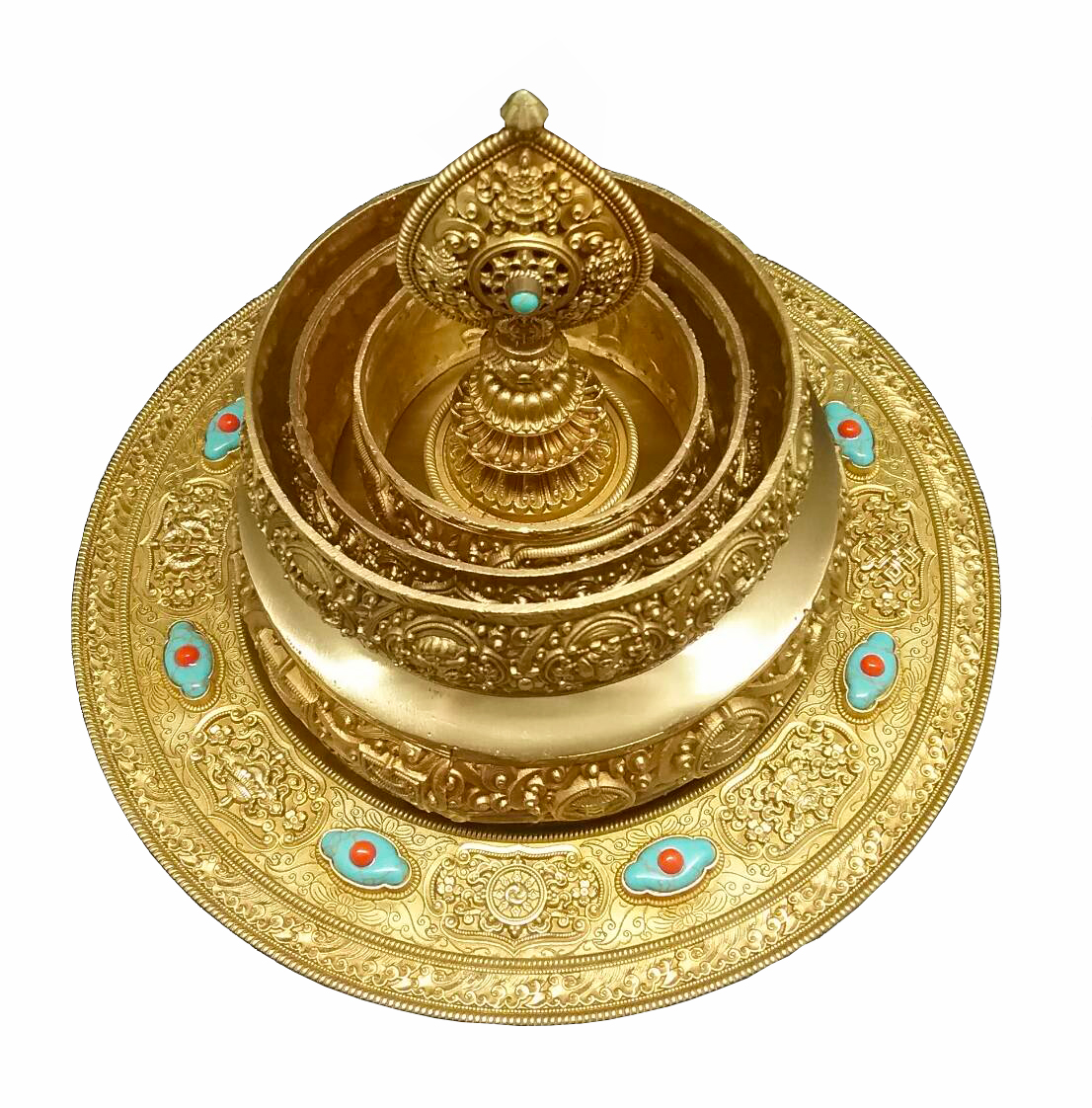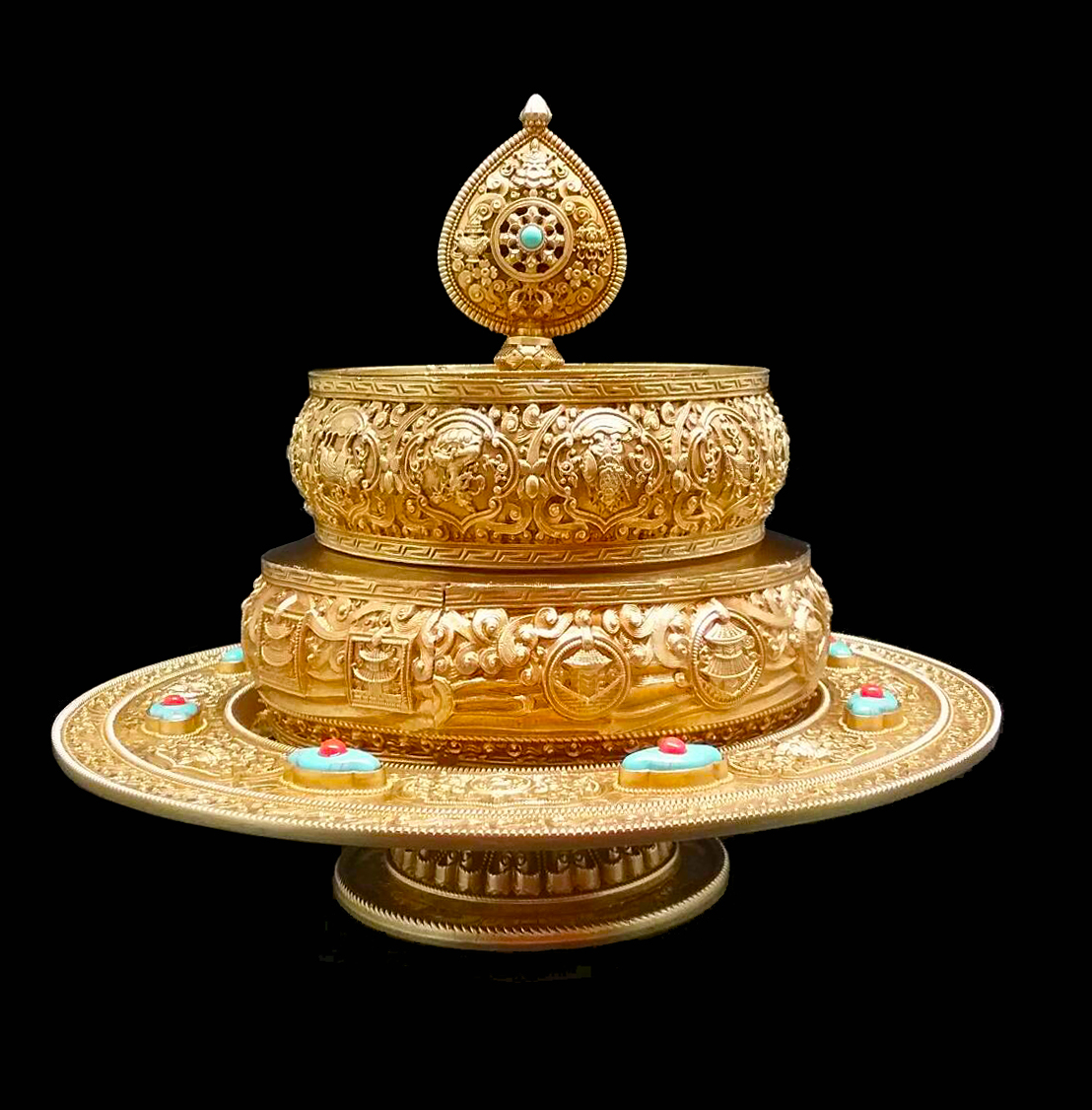|
|
|
Wholesalers: |

|
/ |
|
|
|
|
|
|
|
|
| “If there is any religion that could respond to the needs of modern science, it would be Buddhism.”
― Albert Einstein |
|
|
|
|
|
|
|
|
|
|
|
|
|
|
|
|
|
|
|
| Brass Mandala w/stand 17cm |
|
|
|
|
|
Sku#:3096_C
|
|
|
Wholesale price |
US |
XXX.XX |
|
《In order to view the wholesale price .
Please Apply to be a wholesalers》
|
|
|
|
|
 |
|
Please contact us to verify availability. 1-626-354-6228
Email: zambalallc@gmail.com
America area customers can view on this website first.
https://FlyingMystics.org/ |
|
|
|
|
|
|
Materials: Brass, Cast, Electroplated, Gem-Inlaid
Dimensions: 12 cm, Base 18 cm Diameter (Approximate Diameter * Height)
Description:
The mandala plate (also known as the mandala plate or mandala plate) is an important offering vessel in Tibetan Buddhism, primarily used in the ritual of "Mandala Offering." This ritual, a fundamental practice in Tantric Buddhism, aims to help practitioners accumulate merit and wisdom, symbolically offering the entire universe and its treasures to the Buddhas, Bodhisattvas, deities, protectors, and dakinis. Mandala plates are typically made of copper, silver, or other metals and consist of multiple hollow rings (such as four or more). Practitioners stack rice grains, grains, gems, shells, agates, turquoise, and other materials on the plate, layering them to create a miniature model of the universe. This is not just a material offering, but also a meditation practice, representing the renunciation of attachment and the cultivation of the paramita of generosity.
In Buddhist rituals, mandalas play the following key roles:
- **Accumulating Merit and Resources**: Mandala offerings are considered a quick and effective practice, allowing practitioners to quickly accumulate merit, purify karmic obstacles, and lay the foundation for higher-level tantric practices (such as the Generation and Completion stages). Practitioners accumulate material while chanting mantras (such as "Om Benza Bu Mi Ah Hum") and visualizing the offerings, symbolizing the selfless dedication of all the good things in the world. This practice is particularly common in Tibetan Buddhism's preliminary practices (ngöndro), such as offering 100,000 mandalas as preparation for the preliminary practices.
- **Symbolizing the Universe and Mandala**: The structure of the mandala represents the Buddhist cosmology, with Mount Sumeru at its center, surrounded by the four continents, the sun, and the moon, embodying the concept of "center and periphery" (mandala means "perfection" or "mandala"). In rituals, it serves not only as a physical tool but also as a meditation aid, helping practitioners visualize the perfection and impermanence of the universe and cultivate a non-attachment mindset. Water or perfume is sometimes sprinkled on the plate to symbolize the nourishment of bodhicitta, allowing practice to transcend worldly conduct.
- **Offering and Purification**: During large rituals, empowerment ceremonies, or daily practice, the mandala plate is used to offer to the guru or deity, symbolizing the perfect devotion of the ten dharmakṣṭhānas (the four noble and six ordinary beings). Practitioners may substitute rice or gemstones, focusing on the heart rather than material value. It is also used in prayer rituals, such as those of the Kagyu school, as a vehicle for offering mandalas, helping participants generate bodhicitta.
Overall, in rituals, the mandala plate serves not only as a vehicle for physical offerings but also as a bridge connecting the mundane and the transcendental, emphasizing the teachings of generosity and impermanence. It is suitable for both beginners and advanced practitioners.
Origins of the Mandala Plate
The origins of the mandala plate can be traced back to the tantric traditions of Indian Buddhism. "Mandala" originates from the Sanskrit word "mandala," meaning "mandala," "perfection," "center and edge," or "essence of the universe." It first appears in Indian Tantric texts. Its origins are documented in the Guhyasamaja Tantra, which details the rituals of mandala offerings. During the Song Dynasty in China (circa the 11th century), the Indian monk Shihu (?-1017) translated the relevant text into Chinese, the seven-volume "Sutra on the Supreme Secret Great Teachings of the Three Vajra Karmas of All Tathagatas," introducing this practice to Han Chinese and influencing Tibetan Buddhism.
In Tibetan Buddhism, the development of the mandala plate is closely linked to the four major schools of Buddhism: Nyingma, Sakya, Kagyu, and Gelug. After its introduction from India to Tibet, it became a core tool for preliminary practices, symbolizing a miniature version of the Mount Sumeru mandala. Early mandala plates were mostly simple metal plates, but later evolved into elaborate multi-layered structures inlaid with jewels or strung together with metal wire, reflecting the fusion of Tibetan craftsmanship and Buddhist art. The practice of mandala offering emphasizes "forming a mandala with worldly treasures," with the goal of eliminating attachment and accumulating merit for enlightenment through offerings.
Related Stories
In Buddhist legend, mandala plates are often associated with stories of famous masters, the most famous of which involves the 11th-century Indian master Atisha (982-1054). According to legend, Atisha had two renowned disciples: Dromtonpa and Khampa Lungpa. One day, Dromtonpa visited Khampa and discovered that Khampa's mandala plate was covered in dust, appearing to have been unused for a long time. Surprised, as mandala offering is a crucial practice for accumulating merit, Dromtonpa inquired about Khampa's lack of diligent practice. Khampa replied that he had integrated mandala offering into his daily practice and no longer attached himself to its formality, so the dust on the plate was a symbol of the perfection of his practice.
Later, Tsongtonpa reported this to Atisha, who exclaimed in praise, "This is true practice! Gampahua has transcended external forms and achieved inner perfection." This story emphasizes that the importance of mandala offerings lies not in frequency or material possessions, but in the purity of the mind and non-attachment. It is used to teach students not to reduce practice to a mechanical process but to focus on bodhicitta. This story, often found in Tibetan Buddhist teachings, reminds practitioners that while the mandala plate is important, the ultimate goal is to internalize its spirit.
Another related story illustrates the meritorious power of mandala offerings. Legend has it that a poor practitioner, unable to obtain precious treasures, could only offer rice grains to a mandala. However, his devotion earned him the blessing of his guru, allowing him to rapidly accumulate merit and achieve enlightenment. This reflects the democratic nature of the mandala plate—rich and poor alike can practice generosity through it.
These stories and stories highlight that the mandala plate is more than just a ritual tool; it is an embodiment of Buddhist wisdom, encouraging practitioners to achieve liberation through offerings.



|
|
|
|
|
|
|
|
 |
|
|
|
|
|
|
|
|
|
|
|
|
|
|
|
|
© 2025 Zambala inc. All Rights Reserved. No part of this site may be reproduced without our written Permission.
Service Mail: ZambalaLLC@gmail.com
Phone: (626) 289-9787 or 1(888)Zambala (926-2252)
Fax: (626) 289-9719
1904 West Valley Blvd. Alahambra, CA 91803 USA
Unless stated otherwise in content's license. Design By
|
|
|